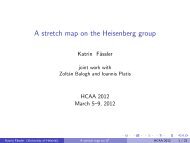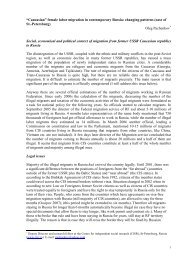THORIUM AS AN ENERGY SOURCE - Opportunities for Norway ...
THORIUM AS AN ENERGY SOURCE - Opportunities for Norway ...
THORIUM AS AN ENERGY SOURCE - Opportunities for Norway ...
You also want an ePaper? Increase the reach of your titles
YUMPU automatically turns print PDFs into web optimized ePapers that Google loves.
Radiation Protection of Man and the Environment<br />
7. RADIATION PROTECTION OF M<strong>AN</strong> <strong>AN</strong>D THE ENVIRONMENT<br />
Radiation protection refers to the protection of man and the environment from negative effects<br />
induced by ionizing radiation emitted from radionuclides. The Th-232 and U-238 decay series<br />
include a number of α-, β- and γ-emitting radionuclides. During the production of energy, other α-,<br />
β- and γ-emitting radionuclides are produced, and some of these will also be present in the waste.<br />
The α-radiation is short-ranged in air and external exposure to α-radiation is easily shielded.<br />
Internal exposure, when α-emitting radionuclides are included in cells due to inhalation or<br />
digestion, can produce detrimental effects, and these nuclides are referred to as highly radiotoxic.<br />
For β-radiation, internal exposure is also of importance, while high energy β-radiation also<br />
contributes to external radiation that must be shielded. The γ-radiation is long-ranged and the<br />
external exposure is of key relevance; lead shielding is required.<br />
When living organisms are exposed to ionising radiation, free radicals are produced, which lead to<br />
oxidative stress and DNA damage, and which may result in effects such as reproduction and<br />
immune system failure, mutation, morbidity and mortality. At very high doses (several Sievert<br />
(Sv) 12 ), deterministic effects such as acute radiation sickness can occur, while at low levels,<br />
stochastic effects due to chronic exposures, such as cancer, may arise in man. High dose-effect<br />
relationships <strong>for</strong> man and most organisms are well known, while at low doses (less than 50 mSv)<br />
the effects are still not fully understood. In<strong>for</strong>mation on low dose-effect relationships <strong>for</strong> nonhuman<br />
organisms is scarce, and is currently being studied in international research programs.<br />
Natural radioactivity in the environment is not regulated, although the Norwegian Radiation<br />
Protection Authority (NRPA) provides advice if indoor exposure to radon is high. To protect man<br />
from “man-made” ionising radiation, conservative dose limits have been set by NRPA: 1 mSv/year<br />
<strong>for</strong> the public; and 20 mSv/year <strong>for</strong> occupational exposed workers in the nuclear industry., For the<br />
latter, permission can be given <strong>for</strong> a limit of 100 mSv over a continuous five-year period, on<br />
condition that the effective dose does not exceed 50 mSv in any single year (Radiation Protection<br />
Act). These limits are in accordance with international recommendations (ICRP). No dose limits<br />
are set <strong>for</strong> the environment. Furthermore, the ALARA principle, according to which doses should<br />
be kept “As Low As Reasonable Achievable” taking social and economic aspects into<br />
consideration, is also valid in <strong>Norway</strong>.<br />
The use of thorium (Th) as an energy source includes:<br />
Front End of the Fuel Cycle Back End of the Fuel Cycle<br />
Mining and Milling Extraction /<br />
Fuel Fabrication<br />
Reactor Operation Spent Fuel Storage<br />
and Reprocessing<br />
Disposal of Waste<br />
and Spent Fuel<br />
The dose contributions from the thorium cycle can be separated into exposures associated with<br />
the front end (mining, milling, extraction and fuel fabrication) and exposures associated with the<br />
back end of the cycle (operation, waste storage, reprocessing, and disposal of waste).<br />
12 Units:<br />
Radiation Emitted from a Source: Desintegration per Second = Becquerel (Bq)<br />
Radiation Absorbed by Living Organisms: Absorbed Dose = Gray (Gy)<br />
The Effect of the Absorbed Dose: Equivalent or Effective Dose = Sievert (Sv)<br />
79

















